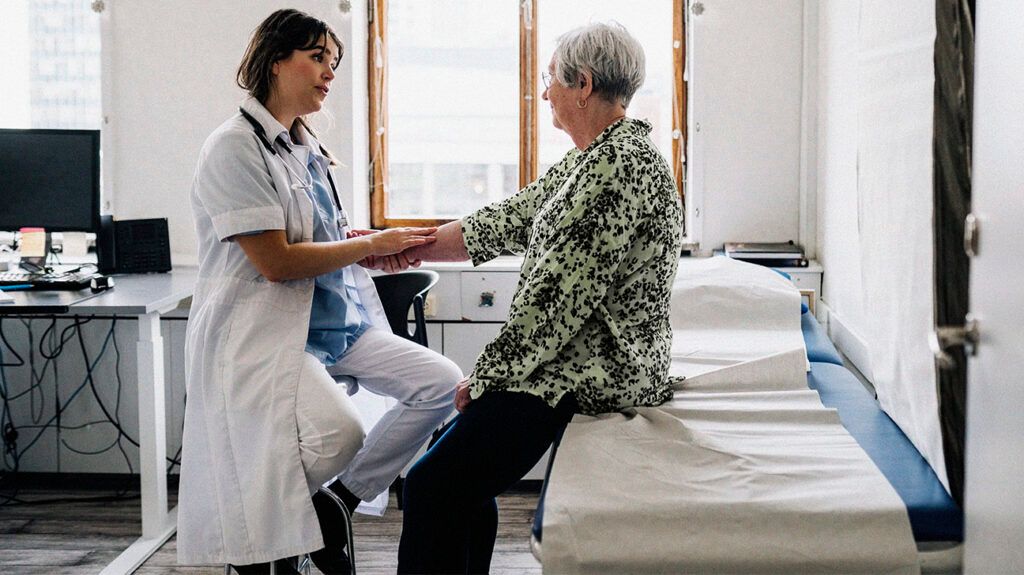Atypical moles and melanoma can have similar features, such as asymmetry, larger than 6 millimeters (mm), and blurred borders. Other signs of melanoma may include itchiness, pain, or rapid changes in appearance.
An atypical mole, also known as a dysplastic nevus, has a larger, more irregular shape than a typical mole. An atypical mole is usually harmless but can increase the risk of developing melanoma, a severe form of skin cancer.
Melanoma is a type of cancer that develops in the melanocytes, the cells that produce the pigment that gives skin its color, melanin.
Melanoma often appears as a new spot on the skin or a change in an existing mole. Early detection and treatment are critical for the best outcomes.
This article discusses how to tell the difference between an atypical mole and melanoma, including treatment and when to speak with a doctor.

Differentiating between an atypical mole and melanoma can be challenging. The following similarities, known as the ABCDE rule, can help indicate an atypical mole or melanoma:
- Asymmetry: One half does not match the other, creating an irregular shape.
- Border: Borders might be ragged, fuzzy, notched, or blurred.
- Color: Both often have mixed colors, including different shades of brown, tan, or pink.
- Diameter: Generally larger than ordinary moles, often greater than 6 mm. However, melanoma may be smaller than this when first detected.
- Evolving: Appearance changes over time. Atypical moles may evolve slower than melanoma, which may show noticeable changes over weeks or months.
Differences
Although atypical moles and melanoma can share several traits, there are some key differences.
For example, melanoma often has more pronounced asymmetry, irregular borders, and varied coloration than atypical moles.
Other differences include:
| Atypical mole | Melanoma |
|---|---|
| usually does not hurt or itch | may itch, hurt, or bleed |
| no rapid changes in size, shape, or color | rapid changes in appearance |
| typically found in sun-exposed areas | can occur anywhere on the body |
Atypical moles, while not cancerous themselves,
The relationship between atypical moles and melanoma is more about the increased risk rather than a direct progression.
People with atypical moles are at a higher risk for melanoma, particularly if they have:
- a large number of atypical moles
- a personal or family history of melanoma
- other risk factors, including fair skin, a history of sunburns, or a weakened immune system
Despite this increased risk, most atypical moles
Atypical moles do not necessarily need treatment. However, people with atypical moles
Treatment options for melanoma depend on the stage and location of the cancer:
- Surgery: The
primary treatment for early-stage melanoma is surgical removal of the tumor and some surrounding tissue. - Sentinel lymph node biopsy: Doctors
may recommend this to determine if the melanoma has spread to nearby lymph nodes. - Immunotherapy: This treatment type
uses medication to boost the body’s immune system to fight cancer. - Targeted therapy: This involves drugs that
target specific genes or proteins in cancer cells. - Chemotherapy: Chemotherapy drugs help kill cancer cells, though it is now
less common for melanoma treatment due to the effectiveness of immunotherapy and targeted therapy. - Radiation therapy: Doctors
may use radiation therapy to relieve symptoms or in cases where melanoma has spread to the brain or other organs. However, it is not a common melanoma treatment. - Clinical trials: Participation in clinical trials
can provide access to new therapies.
Should a person remove atypical moles?
Not all atypical moles
- changes in the mole
- biopsy results
- the number of moles
- personal and family history of skin cancer
Regular monitoring and consultations with a dermatologist are key in managing the risk.
Atypical moles are not always a cause for concern. However, melanoma requires prompt treatment for the best outcomes. A person should speak with a doctor or dermatologist if they experience:
- new moles or skin lesions, especially if they look different from other moles
- changes in existing moles
- itching, bleeding, or crusting
- moles or lesions that align with the ABCDEs of melanoma
- a large number of moles
The Skin Cancer Foundation recommends that people keep track of existing moles so they can more easily detect changes.
Atypical moles share some symptoms with melanomas, such as irregular edges, asymmetry, and multiple colors. Melanoma may also cause pain, itching, and bleeding or may change rapidly in appearance.
However, not all melanoma will fit the above descriptions perfectly.
People should have regular skin checks and consult a healthcare professional if they notice any changes in their moles or skin. Early detection is key to the effective treatment of melanoma.
